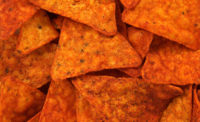Say Cheese
Say Cheese
by James Dudlicek
Breaded appetizers and other cheese-related snacks are the focus of Sargento’s Kiel, Wis., plant.
Sargento Foods Inc. is well-known for the slices, shreds and other retail cheese products that boldly carry the company’s brand name. But Sargento also plays a less visible yet crucial role in making, for example, mozzarella sticks enjoyed by quick-casual dining patrons nationwide, and many variations on the cracker-and-cheese theme for portable snack packs.
These products, along with Sargento’s own new shelf-stable Cheese Dips! snacks and shreds for foodservice, make up the output of the company’s manufacturing facility in Kiel, Wis., about a half-hour’s drive north of the company’s Plymouth, Wis., headquarters.
Here, the plant’s 325 employees work in three departments — frozen appetizers, non-refrigerated snacks and shreds. All three areas are kept separate from the others to conduct sanitation at will without disrupting any of the lines, explains plant manager Mark DeNoble.
The shipping and receiving department for raw materials and finished goods operates around the clock, five days a week, and can load or unload a truck in 45 minutes or less, DeNoble says.
All products made in Kiel are trucked to Plymouth for final distribution, and all finished frozen goods are stored for one to two days before shipment via Sargento’s frozen distribution system.
The Kiel plant is home to a variety of proprietary processes, many of which are more closely guarded than Sargento’s own lines back in Plymouth in order to protect the company’s numerous high-profile, national clients.
For example, Sargento makes breaded appetizers for various casual-dining restaurant chains. All contain cheese of some sort, but each is specifically designed for each customer. Products include breaded mozzarella in an assortment of shapes, including sticks, wedges and stars; stuffed jalapeño peppers; and vanilla cheesecake cubes.
Cheese for a typical breaded snack line is usually cut by the supplier, but shapes can be custom cut on site, DeNoble says. The cheese shapes travel down a conveyor to be enrobed in breading before they’re frozen and packaged. Breaded snacks are generally delivered frozen and then fried or baked by the end user, DeNoble explains.
Non-refrigerated portable snacks made at Kiel, include Sargento’s Cheese Dips, a line of shelf-stable processed-cheese dips packaged with various crackers, chips and pretzels. Also made here are smaller snacks suitable for lunchboxes and purses, including pretzels, breadsticks and cookies in packs with cheese dips and confectionery creams. There’s also a s’mores snack pack that features two small graham crackers, a mini chocolate bar and a small plastic stick that the consumer uses to spread the marshmallow cream that holds the tiny sandwich together.
Finally, Kiel’s shreds lines produce bulk bags for foodservice and institutional use, along with portion-controlled packs for pre-packaged salad kits.
Plant equipment is quite versatile. For example, DeNoble says, a large-batch blender could be used to create a “matrix” of cheese, vegetables and precooked meat; this blend would then be shaped, breaded and frozen. Such a mixer churns out batches encompassing thousands of pounds of mix that’s transferred to smaller barrels for use on the plant floor.
Lee McCollum, vice president of manufacturing, notes that processes at Kiel are highly automated. There’s an automatic box erecting and gluing operation to make shipping containers. The breaded line sports an automatic case sealer and palletizer, though the boxes themselves are packed by hand.
A cooler holds both raw materials awaiting their turn on the floor as well as finished goods headed to Plymouth for distribution. The racks are designed to accommodate pallets and 640-lb. cheese blocks.
At washdown time, operators clean their own machinery. “You have a lot more ownership of what it takes to do the job,” DeNoble says. “It has a tremendous impact on quality control.”
Ergonomic improvements made at Kiel include a prototype box-cutting machine designed to eliminate the seven human-made cuts required to open a corrugated box of cheese; a waist-high conveyor that eliminates the manual sliding of cheese blocks across a table; and a tote dumper that renders obsolete the strenuous practice of dumping 30-lb. boxes of ingredients.
Editor’s Note: James Dudlicek is editor of Stagnito’s Dairy Field magazine.
Looking for a reprint of this article?
From high-res PDFs to custom plaques, order your copy today!





